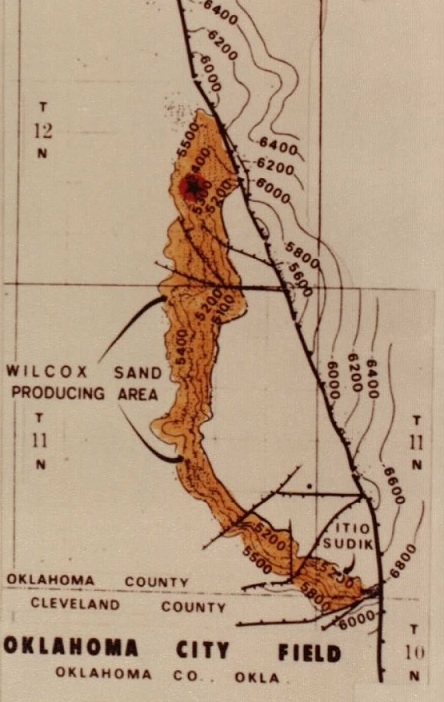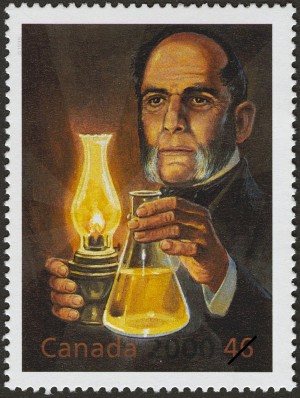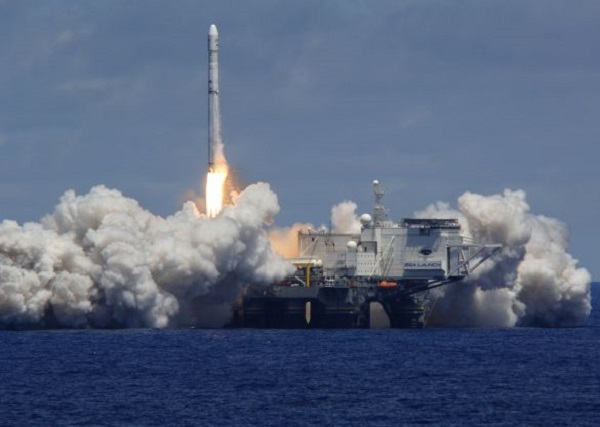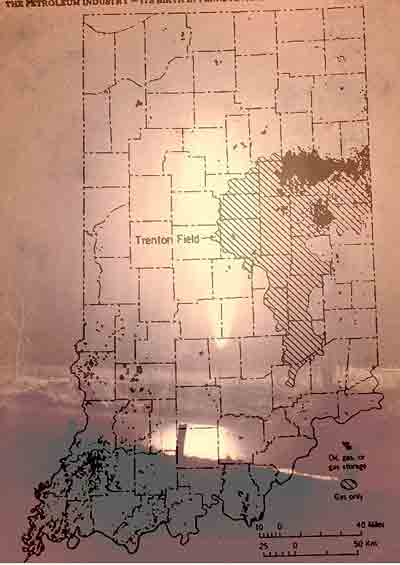March 26, 1930 – Oklahoma City’s “Wild Mary Sudik” makes Headlines –
What would become one of Oklahoma’s most famous wells struck a high-pressure formation about 6,500 feet beneath Oklahoma City and oil erupted skyward. The Indian Territory Illuminating Oil Company’s Mary Sudik No. 1 flowed for 11 days before being brought under control. It produced about 20,000 barrels of oil and 200 million cubic feet of natural gas daily, becoming a worldwide sensation.

Highly pressured natural gas from the Wilcox formation proved difficult to control in the prolific Oklahoma City oilfield. Within a week of a 1930 gusher, Hollywood newsreels of it appeared in theaters across America. Photo courtesy Oklahoma History Center.
Efforts to control the well in Oklahoma City’s prolific oilfield (discovered in 1928) were featured in movie newsreels and on radio broadcasts. It was later learned that after drilling more than a mile deep, the exhausted crew did not know the Wilcox Sand oil formation was permeated with highly pressurized natural gas, according to the Oklahoma History Center in Oklahoma City.

Map of the Wilcox sands formation of the Oklahoma City oilfield in the 1940s.
Although the first ram-type blowout preventer (BOP) had been patented in 1926, many high-pressure oilfields would take time to tame.
Learn more about the well that became known as “Wild Mary Sudik.”
March 27, 1855 – Canadian Chemist trademarks Kerosene
Canadian physician and chemist Abraham Gesner (1797-1864) patented a process to distill coal into kerosene. “I have invented and discovered a new and useful manufacture or composition of matter, being a new liquid hydrocarbon, which I denominate Kerosene,” he proclaimed. Because his new illuminating fluid was extracted from coal, consumers called it “coal oil” as often as kerosene.

On March 17, 2000, Canada issued one million commemorative stamps featuring kerosene inventor Abraham Gesner.
Gesner, considered the father of Canada’s petroleum industry, in 1842 established the country’s first natural history museums, the New Brunswick Museum, which today houses one of Canada’s oldest geological collections.
The U.S. petroleum industry began when it was learned that oil could be distilled into a lamp fuel (and much later, a rocket fuel). With new oilfields discovered in Pennsylvania, West Virginia, and Ohio, inexpensive kerosene became America’s main source of light.
Learn more in Camphene to Kerosene Lamps.
March 27, 1975 – First Pipe laid for Trans-Alaskan Pipeline
With the laying of the first section of pipe in Alaska, construction began on the largest private construction project in American history at the time. Recognized as a landmark of engineering, the 800-mile Trans-Alaska Pipeline system, including pumping stations and the Valdez Marine Terminal, would cost $8 billion by the time it was completed in 1977.
Learn more in Trans-Alaska Pipeline History.
March 27, 1999 – Offshore Platform Rocket Launch Test
The Ocean Odyssey, a converted semi-submersible drilling platform, launched a Russian rocket that placed a demonstration satellite into geostationary orbit.
The Zenit-3SL rocket, fueled by liquid oxygen and kerosene rocket fuel, was part of Sea Launch, a Boeing-led consortium of companies from the United States, Russia, Ukraine, and Norway. The platform had once been used by Atlantic Richfield Company (ARCO) for North Sea exploration.

With an orbital test on March 27, 1999, the Ocean Odyssey, a converted semi-submersible drilling platform, became the world’s first floating equatorial launch pad. Photo courtesy Sea Launch.
“The Sea Launch rocket successfully completed its maiden flight today,” Boeing announced. “The event, which placed a demonstration payload into geostationary transfer orbit, marked the first commercial launch from a floating platform at sea.”
The Sea Launch consortium provided orbital launch services until 2014, when Russia invaded and annexed the Crimean Peninsula of Ukraine.
Learn more in Offshore Rocket launcher.
March 28, 1886 – Discovery launches Indiana Natural Gas Boom
A drilling boom began at Portland, Indiana, after the Eureka Gas and Oil Company found a natural gas field at a depth of only 700 feet. The discovery arrived just two months after a spectacular natural gas well about 100 miles to the northeast — the “Great Karg Well” of Findlay, Ohio.

According to industrialist Andrew Carnegie, natural gas daily replaced 10,000 tons of coal for making steel.
Portland foundry owner Henry Sees had followed the news from Findlay. He persuaded local investors to drill for Indiana natural gas. In western Pennsylvania, reserves found near Pittsburg had encouraged industrialists there to replace their coal-fired steel and glass foundries with the first large-scale industrial use of natural gas.
Indiana would become the world’s largest natural gas producer, thanks to its Trenton limestone stretching more than 5,100 square miles across 17 counties. Within three years, more than 200 companies were drilling, distributing, and selling natural gas.
Learn more in Indiana Natural Gas Boom.
March 28, 1905 – Oil Boom begins in North Louisiana
An oilfield discovery in Caddo Parish, Louisiana, created a classic boom town in Oil City and brought economic prosperity to northern Louisiana. The Offenhauser No. 1 well was completed at a depth of 1,556 feet, but the well yielded only five barrels a day and was abandoned. More productive wells soon followed, and the Caddo-Pine Island oilfield, about 20 miles northwest of Shreveport, expanded to include more than 80,000 acres.

The Shreveport Chamber of Commerce in 1955 dedicated a 40-foot monument commemorating the 50th anniversary of oil in Caddo Parish. Photo by Bruce Wells.
“This part of Louisiana, of course, was built on the oil and gas industry, and those visitors interested in the technical aspects of oilfield work will find the museum particularly appealing,” notes the Louisiana State Oil and Gas Museum (formerly the Caddo-Pine Island Oil and Historical Museum). More oilfield history can be found at Shreveport, where natural gas was discovered in 1870, thanks to an ice plant’s water well. To prevent the waste of natural gas through flaring, Louisiana passed its first conservation law in 1906.
Learn more in Louisiana Oil City Museum.
March 28, 1918 – Oil Research Center Opens in Oklahoma
The U.S. Bureau of Mines established the first U.S. oil and natural gas research and development center in Bartlesville, Oklahoma. Two years earlier, independent producers had pledged $50,000 to help build the bureau’s Bartlesville Experiment Station. Discoveries in the Osage Nation had “catapulted Oklahoma to the forefront of the burgeoning mid-continent oil industry,” according to the U.S. Office of Fossil Energy.
March 29, 1819 – Birthday of Father of the Petroleum Industry
Edwin Laurentine Drake (1819-1880) was born in Greenville, New York. Forty years later, he used a steam-powered cable-tool rig to drill the first commercial U.S. oil well at Titusville, Pennsylvania. The former railroad conductor overcame many financial and technical obstacles to make “Drake’s Folly” a milestone in energy history.

Edwin L. Drake (1819-1880) invented a method of driving a pipe down to protect the integrity of America’s first oil well. Photo courtesy Drake Well Museum.
Drake pioneered using iron casing to isolate his well from nearby Oil Creek. “In order to overcome the hurdles before him, he invented a ‘drive pipe’ or ‘conductor,’ an invention he unfortunately did not patent,” noted historian Urja Davé in 2008. “Mr. Drake conceived the idea of driving a pipe down to the rock through which to start the drill.”
Determined to find oil for refining into the popular lamp fuel kerosene, Drake created the American petroleum industry on August 27, 1859, at a depth of 69.5 feet.
Visit the Drake Well Museum in Titusville.
March 29, 1938 – Magnolia Oilfield Discovery in Arkansas
A well drilled by Kerlyn Oil Company (predecessor to the Kerr-McGee company) revealed the 100-million-barrel Magnolia oilfield in Arkansas, adding to 1920s giant oilfield discoveries at El Dorado and Smackover. “Wildcat Strike In Southern Arkansas is Sensation of the Oil Country” proclaimed the local newspaper.
Drilling on the Barnett No. 1 well had been suspended by a lack of funds, but Kerlyn Oil Company Vice President Dean McGee persevered. An experienced geologist, McGee was rewarded with the giant oilfield discovery at a depth of 7,650 feet. He would later lead efforts in early offshore exploration in the Gulf of Mexico.
March 30, 1980 – Deadly North Sea Gale
Massive waves during a North Sea gale capsized a floating apartment for Phillips Petroleum Company workers, killing 123 people. The Alexander Kielland platform, 235 miles east of Dundee, Scotland, housed 208 men who worked on a nearby rig in the Ekofisk field. Most of the Phillips workers were from Norway. The platform, converted from a semi-submersible drilling rig, served as overflow accommodation for the Phillips production platform 300 yards away.
_______________________
Recommended Reading: The Oklahoma Petroleum Industry (1980); Oil Lamps The Kerosene Era In North America
(1978); Amazing Pipeline Stories: How Building the Trans-Alaska Pipeline Transformed Life in America’s Last Frontier
(1997); The Extraction State, A History of Natural Gas in America (2021); Myth, Legend, Reality: Edwin Laurentine Drake and the Early Oil Industry
(2009); Texas Oil and Gas, Postcard History
(2013); Early Louisiana and Arkansas Oil: A Photographic History, 1901-1946
(1982). Your Amazon purchase benefits the American Oil & Gas Historical Society. As an Amazon Associate, AOGHS earns a commission from qualifying purchases.
_______________________
The American Oil & Gas Historical Society (AOGHS) preserves U.S. petroleum history. Become an AOGHS annual supporting member and help maintain this energy education website and expand historical research. For more information, contact bawells@aoghs.org. Copyright © 2024 Bruce A. Wells. All rights reserved.


